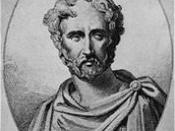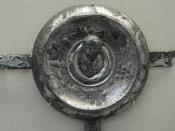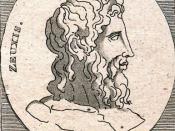Though the Greeks have been known throughout the world for their excellent sculptures and amphorae, they must also be credited for mastering panel painting. The main reason that they are not more widely known of is the plain fact that many have either been destroyed or depleted throughout the years. Some of the most complete surviving examples of early Greek panel painting are scenes of banqueting and diving painted by an unknown artist for a tomb at Paestum, Italy. The figures in the Paestum frescoes show skillful drawing and a developed understanding of human anatomy. The artist has drawn eyes in profile, instead of frontally, and included elements of landscape.
According to literary sources, the 5th century bc produced a host of great painters. Polygnotus, who worked at Delphi and Athens in the 460s and 450s, was famed for giving character to the faces of his figures. He also sought to show depth by placing figures above and below one another on the wall, as if the ground they stood on receded in space.
Other Classical era painters include Micon of Athens and Panainos, brother of the sculptor Phidias. Micon and Panainos decorated a building in Athens, known as the Painted Stoa, with a painting of a celebrated encounter between Persians and Greeks, the Battle of Marathon. Among High Classical painters, Agatharchus was said to have established new methods for the depiction of receding space, and Apollodorus to perfect the depiction of highlights and shading.
The leading painters of the 4th century bc were Zeuxis, also noted for his skillful handling of light and shadow, and Parrhasios, noted for his skill at line and contours. Apelles was perhaps the most celebrated painter of them all. Although none of his works survive, descriptions of them inspired artists of the Italian Renaissance,


